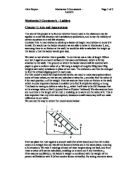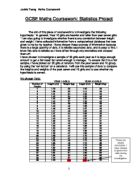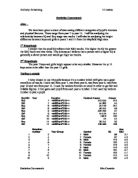Mechanics 2 Coursework - Ladders
Chapter 1: Aim and Assumptions
The aim of this project is to find out whether theory used in the classroom can be applied to a real life situation with satisfactory predictions, and to test the validity of certain equations in a real life situation.
Consider this: A man wishes to climb up a ladder of height l and wishes to know if it is safe. He would use the ladder situation we are able to solve in Mechanics 2, and, assuming there is no friction at the wall, he would be able to calculate the height up the ladder x that the ladder would give way.
We wish to test whether this is possible. To do this we use a ruler of length 100cm and rest it against a smooth surface (in this case a whiteboard, which is firmly attached to the wall). The ground on which the ladder stands will be covered with paper to give a uniform value of m. We hang a weight of roughly 200g (two 100g weights each side) to balance in place of our man. The distance x can then be changed to find the critical slipping point in each case.
Chapter 1: Aim and Assumptions
The aim of this project is to find out whether theory used in the classroom can be applied to a real life situation with satisfactory predictions, and to test the validity of certain equations in a real life situation.
Consider this: A man wishes to climb up a ladder of height l and wishes to know if it is safe. He would use the ladder situation we are able to solve in Mechanics 2, and, assuming there is no friction at the wall, he would be able to calculate the height up the ladder x that the ladder would give way.
We wish to test whether this is possible. To do this we use a ruler of length 100cm and rest it against a smooth surface (in this case a whiteboard, which is firmly attached to the wall). The ground on which the ladder stands will be covered with paper to give a uniform value of m. We hang a weight of roughly 200g (two 100g weights each side) to balance in place of our man. The distance x can then be changed to find the critical slipping point in each case.







